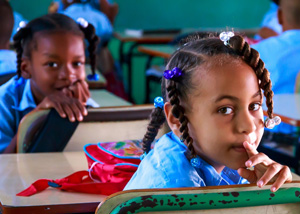 However, the digest suggests that these perceptions are not supported by primary data and have not directed the research agenda of researchers.
However, the digest suggests that these perceptions are not supported by primary data and have not directed the research agenda of researchers.
The Trinidad and Tobago Vision 20/20 development plan suggests that, “young offenders, young parents, ‘ghetto’ youth, low educational achievers, and school drop outs” (ECLAC, 2012, p 22) are particularly vulnerable to involvement in crime and violence and should therefore be the focus of government responses. The popular correlation of school dropouts with anti-social behaviour is reflected in the following quote from Opposition MP Colm Imbert in 2010:
If you look at the typical gang member in Trinidad and Tobago, it's a high school dropout, the person may have dropped even before they got to high school, they are social outcasts, they are illiterate, they are unskilled, they are unable to find employment because they have no skill and they fall easy prey to the recruitment exercises of the gang (cited in Ramdass, 2010).
Certain urban places, such as Morvant and San Juan/Laventille in the St. George West school district are socio-spatially stigmatized and marginalized; however, a cursory examination of dropout data from the Ministry of Education reveals that the school district with the highest number of dropouts, and the highest number of female dropouts, after primary school is the south district of Victoria (MOE, 2004, pp 54-55). Consequently, the social and economic geographies of school dropouts must be analyzed empirically to strengthen the networks and resilience of individuals and households in communities of greatest need.
We simply do not know enough about dropout statistics, including why it appears that more young women in South are dropping out of school compared to young women in other parts of the country, and students’ pursuits since dropping out. Furthermore, while studies on school-avoidance have included the experiences of LGBTQQ youth in the global north (Darwich et al, 2012; Vare and Norton, 1998), Caribbean studies have yet to examine the relationship between sexuality and exclusion in education. This research seeks to begin to address these gaps.
 While the motivation for changes in policy direction exists amongst a variety of stakeholders, including government and NGOs, there is a persistent lack of reliable primary data examining the link between educational attainment, dropout decision-making, and economic livelihoods (MOE, 2004). This research gap has been insufficiently bridged by theory and anecdote. Therefore, the goal of this study is to generate empirical evidence to fill the existing gaps in the discourse of school dropouts. In addition, it will provide the evidence required to affect the agendas of NGOs and Government, including the Ministries of Education, National Security, Gender and Youth, and People and Social Development, and get citizens critically thinking about education systems and the need for effective in-school interventions and relevant out-of-school alternatives and transitions that contribute to dignified work, community empowerment, and household resilience.
While the motivation for changes in policy direction exists amongst a variety of stakeholders, including government and NGOs, there is a persistent lack of reliable primary data examining the link between educational attainment, dropout decision-making, and economic livelihoods (MOE, 2004). This research gap has been insufficiently bridged by theory and anecdote. Therefore, the goal of this study is to generate empirical evidence to fill the existing gaps in the discourse of school dropouts. In addition, it will provide the evidence required to affect the agendas of NGOs and Government, including the Ministries of Education, National Security, Gender and Youth, and People and Social Development, and get citizens critically thinking about education systems and the need for effective in-school interventions and relevant out-of-school alternatives and transitions that contribute to dignified work, community empowerment, and household resilience.
Why is this research necessary?
There is a persistent lack of reliable primary data examining the link between educational attainment, dropout decision-making, and economic livelihoods (MOE, 2004). This study seeks to generate empirical evidence to fill the existing gaps in the discourse of school dropouts.
To provide the evidence required to affect the agendas of NGOs and Government, including the Ministries of Education, National Security, Gender and Youth, and People and Social Development toward building human capital through the implementation of social interventions that support individuals, families and communities with the tools and resources to avoid truancy, delinquency, gang involvement and criminality.
To get citizens to critically think about education systems and the need for effective in-school interventions and relevant out-of-school alternatives and transitions that contributes to dignified work, community empowerment, and household resilience.
